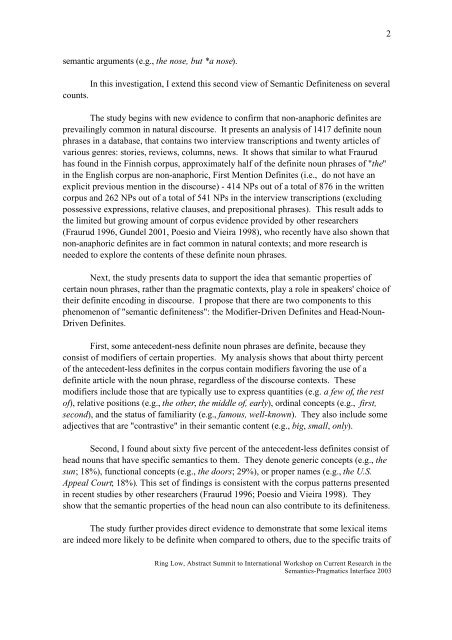SemPrag03.Progr.pdf - Institut für Linguistik/Germanistik - Universität ...
SemPrag03.Progr.pdf - Institut für Linguistik/Germanistik - Universität ...
SemPrag03.Progr.pdf - Institut für Linguistik/Germanistik - Universität ...
You also want an ePaper? Increase the reach of your titles
YUMPU automatically turns print PDFs into web optimized ePapers that Google loves.
2<br />
semantic arguments (e.g., the nose, but *a nose).<br />
In this investigation, I extend this second view of Semantic Definiteness on several<br />
counts.<br />
The study begins with new evidence to confirm that non-anaphoric definites are<br />
prevailingly common in natural discourse. It presents an analysis of 1417 definite noun<br />
phrases in a database, that contains two interview transcriptions and twenty articles of<br />
various genres: stories, reviews, columns, news. It shows that similar to what Fraurud<br />
has found in the Finnish corpus, approximately half of the definite noun phrases of "the"<br />
in the English corpus are non-anaphoric, First Mention Definites (i.e., do not have an<br />
explicit previous mention in the discourse) - 414 NPs out of a total of 876 in the written<br />
corpus and 262 NPs out of a total of 541 NPs in the interview transcriptions (excluding<br />
possessive expressions, relative clauses, and prepositional phrases). This result adds to<br />
the limited but growing amount of corpus evidence provided by other researchers<br />
(Fraurud 1996, Gundel 2001, Poesio and Vieira 1998), who recently have also shown that<br />
non-anaphoric definites are in fact common in natural contexts; and more research is<br />
needed to explore the contents of these definite noun phrases.<br />
Next, the study presents data to support the idea that semantic properties of<br />
certain noun phrases, rather than the pragmatic contexts, play a role in speakers' choice of<br />
their definite encoding in discourse. I propose that there are two components to this<br />
phenomenon of "semantic definiteness": the Modifier-Driven Definites and Head-Noun-<br />
Driven Definites.<br />
First, some antecedent-ness definite noun phrases are definite, because they<br />
consist of modifiers of certain properties. My analysis shows that about thirty percent<br />
of the antecedent-less definites in the corpus contain modifiers favoring the use of a<br />
definite article with the noun phrase, regardless of the discourse contexts. These<br />
modifiers include those that are typically use to express quantities (e.g. a few of, the rest<br />
of), relative positions (e.g., the other, the middle of, early), ordinal concepts (e.g., first,<br />
second), and the status of familiarity (e.g., famous, well-known). They also include some<br />
adjectives that are "contrastive" in their semantic content (e.g., big, small, only).<br />
Second, I found about sixty five percent of the antecedent-less definites consist of<br />
head nouns that have specific semantics to them. They denote generic concepts (e.g., the<br />
sun; 18%), functional concepts (e.g., the doors; 29%), or proper names (e.g., the U.S.<br />
Appeal Court; 18%). This set of findings is consistent with the corpus patterns presented<br />
in recent studies by other researchers (Fraurud 1996; Poesio and Vieira 1998). They<br />
show that the semantic properties of the head noun can also contribute to its definiteness.<br />
The study further provides direct evidence to demonstrate that some lexical items<br />
are indeed more likely to be definite when compared to others, due to the specific traits of<br />
Ring Low, Abstract Summit to International Workshop on Current Research in the<br />
Semantics-Pragmatics Interface 2003

















